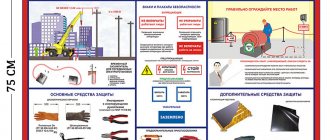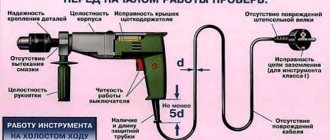Modern life and production cannot be imagined without electricity; lighting devices, various pumps and other equipment operate with its help. Thanks to electricity, human life has become much simpler; there is no need to go long distances to fetch water or heat your home with wood. But along with many advantages, the consumption of electricity has a main disadvantage - it is very dangerous to health: direct contact of a person with electric current can result in injuries that are incompatible with life. This article discusses the types of electric shock, the main injuries that accompany the shock, as well as the primary actions in the event of an emergency, providing first aid to victims.
Electric shock
The effect of current on the body
Based on the physical impact on a living organism, several types of injuries can be distinguished that occur after electric shock. These include:
- Thermal influence. Characterized by an increase in body temperature, heart and blood vessels located along the path of the discharge, as well as burns of varying degrees in some areas of the skin and internal organs;
- The electrolytic properties of the current when exposed to the body form the decomposition of fluids in the blood, which completely changes its chemical composition, the blood “boils” and clogs the blood vessels;
- As a result of the biological action, the electric current irritates muscle tissue, which leads to spontaneous contractions of muscles, including the lungs and heart. The consequence of such exposure may be respiratory failure, even stopping, as well as fibrillation of the heart muscle, cardiac arrest;
- The mechanical effect that current has is characterized by rupture of muscle tissue, blood vessels and other organs. This occurs due to the instantaneous formation of steam inside the blood and a high-power impact on the tissue.
The listed types of electric shock can occur either together or separately from each other, it depends on the force of the shock, the height of the voltage, and how long the discharge was in direct contact with the skin.
Electric shock at home
There are a number of signs that indicate that a person has suffered an electric shock. First of all, this is the formation of burns on the skin, at the places where the charge enters and exits, which can be of varying degrees, depending on the strength of the current. Such traces need to be looked for based on the condition of the victim; as a rule, in the part located closer to the ground there is an exit spot, and in the upper part there is an entrance spot.
Also, muscle spasm indicates an electrical injury. Such symptoms are present in the first minutes after receiving a shock, when the current has not yet completely left the body. As a rule, the consequences of such a spasm are not dangerous and do not cause major injuries or burns.
Steam coming from the victim is also a sign of a strong electric shock, when the discharge caused instantaneous evaporation of moisture due to high temperature. First aid in this case must be provided only after making sure that the person is no longer in contact with the electricity line.
Occupational Safety and Health. Electrical safety.
1. Definitions:
· Occupational Safety and Health
– a system for preserving the life and health of workers in the process of work, which includes measures – legal, social-economic, organizational and technical, sanitary and hygienic, treatment and preventive, rehabilitation.
· Safety precautions
– system of organizational measures and technical. means to prevent exposure of workers to hazardous industries. factors.
· Safety
– state of working conditions, at cat. exposure of workers to dangerous and harmful production factors is excluded.
· Working conditions
– a set of factors of production. environments that influence human health during the work process. There are safe, harmful, acceptable, normal, dangerous (extreme), optimal.
· Harmful production factor
– production factor, impact cat. on the employee may lead to his illness.
· Hazardous production factor
– production factor, impact cat. on the employee may result in personal injury.
· Industrial sanitation
– a system of organizational, hygienic and sanitary measures and means to prevent exposure of workers to hazardous industries. factors.
· Individual funds and count. worker protection
– tech. means used to prevent or reduce exposure of workers to harmful and (or) hazardous production factors, as well as to protect against pollution.
· Occupational health
- a system for ensuring the health of workers in the process of work, including measures - legal, social-economic, organizational, technical, sanitary-hygienic, treatment-and-prophylactic, rehabilitation.
· Injury safety
– compliance of workplaces with occupational safety requirements that exclude injury to workers under the conditions established by regulatory legal acts on occupational safety.
· Safe working conditions
– working conditions, at cat. exposure to harmful and (or) hazardous production factors on workers is excluded or their exposure levels do not exceed acceptable standards.
We advise you to study What voltage should be on the battery
· Harmful working conditions
– working conditions characterized by the presence of harmful production factors that exceed hygienic standards and have an adverse effect on the worker’s body.
· Accident at work
– an event resulting in a cat. the insured was injured or otherwise damaged while performing his duties under an employment agreement (contract) and in other cases, both on the territory of the insured and beyond, or while traveling to or returning from work on the insured's transport, which . entailed for the insured the need to transfer to another workplace, loss of professional ability to work (temporary or permanent), and his death.
· The effect of current on living tissue
– thermal, electrolytic, mechanical, biological.
· Two types of electrical injuries -
local and electric shocks (5 degrees).
· Local e/trauma
– e/burns, e/signs, metallization of the skin, mechanical damage, e/ophthalmia.
· E/burns
– current (contact) and arc (4 degrees of burn).
· The outcome of the impact of current on a person
depends on the value and duration of the current passing through his body, the type and frequency of the current, and the individual properties of the person.
2. Electrical safety. Terms and Definitions
(SSBT, GOST 12.1.009-76)
Classification of electric shock
There is a division of types of injury to a person due to electric shock, based on the nature and area of injury:
- Local, when a person receives injuries of a local nature, for example, to the arms, legs or other parts of the body;
- General injuries, more global, affect the entire body, for example, shock, mechanical shock when touching a conductor. The consequences of such an impact are much more dangerous; recovery from an impact will take much longer; often the person remains disabled or even dies.
Local
Basic protection against electric shock
Among the above types of damage, local electrical injury is the most common, since, first of all, when touching a bare conductor, the limbs and the areas closest to them suffer. Local damage may include:
- Electrical burn. This is damage to one or more areas of the skin as a result of a short-term temperature jump on the conductor when a short circuit or network overload occurs. Most often, the victims of such an incident are electricians and maintenance personnel who work on connecting power lines and related equipment;
Important! To be allowed to perform such work, personnel must undergo safety training and have a certificate confirming their qualifications in the third or fourth group.
Electric shock sign
- Electrical signs are formed on the victim’s body in almost every case; they are characterized by rough skin in a small area, as a rule, precisely at the point where the person touches the conductor. Such a burn is not critical and can be treated fairly quickly, but there are cases when, after prolonged interaction with a source of electricity, long marks remain on the skin, similar to a fine mesh. They are not life-threatening, but the victim may feel moderate pain in this area for some time;
- Metallization of leather. This is a type of local damage that can be identified by characteristic particles around the burn. Such a plaque forms on the skin as a result of the instantaneous formation of high temperature between two conductors of different polarities, which leads to the destruction of the metal, the particles of which fly away in different directions and quickly cool. This damage is not life-threatening, the deformed areas gradually disappear and the wound heals;
Important! If such a crumb gets on the mucous membrane of the eye, you must urgently go to the hospital, since the consequences of such an injury can be much more serious, including complete loss of vision. Most often, this phenomenon occurs when disconnectors are turned off or during a short circuit, so during such actions it is necessary to wear a protective mask and long-sleeved rubber gloves.
Radiation from arc welding
- Electroophthalmia. A type of electrical injury that occurs not through direct contact with a conductor or power source, but when the mucous membrane of the eye is damaged by an electric arc. This glow is so strong that simply looking at it, ultraviolet light burns the cornea, then the eyes become inflamed. Treatment and recovery period, depending on the severity of the damage, can last from 6 hours to 7 days. Most often, such a burn occurs if you look at metal arc welding with an unprotected eye;
- Mechanical injuries resulting from direct contact with electricity, such as ruptures of soft tissue or skin. When exposed to current, muscles begin to contract uncontrollably, which leads to their ruptures and deformations. The consequences of such injuries can only be eliminated by surgical intervention by stitching the tear and applying a bandage. Ruptures of internal organs lead to much more disastrous consequences, since, at first glance, it is impossible to determine the injury, and if the bleeding is not localized and its cause is not eliminated, the victim will quickly lose a lot of blood and may die. Often, muscle contraction leads to bone fractures and joint dislocations; only specialists should set them.
Important! Do not confuse injuries to joints and bones resulting from a fall from an electric shock with electrical injuries. This is a completely different type of injury and should be treated accordingly.
Are common
General injuries include electrical shock and shock. The impact of such factors causes a failure of the most important functions in the human body and the failure of some control organs.
Electric shock is a type of electrical injury in which the entire human body is in increased tone, the current provokes spasms in the respiratory and circulatory systems, which leads to increased or stopped breathing, and blood pressure increases several times.
The effect of current during such an injury can be divided into two phases:
- Excitation phase, when the current provokes uncontrollable spasms of muscles and tissues;
- The phase of inhibition or exhaustion. At this stage, all body systems fail, blood pressure drops rapidly, the pulse quickens, the person feels anxious and depressed. This condition can last from 10 minutes to a day, and if no medical measures are taken, the consequences can be much worse, even death.
Electric shock is a consequence of the impact of a charge when current flows through the human body. Such an injury is accompanied by muscle cramps, the victim is distracted and cannot concentrate; this condition can last for several days. Even if a person has received medical care, he is still considered unrecovered and with a weak immune system.
Electric shock, depending on the severity of the victim’s condition, can be classified into 4 categories:
- In the first degree, convulsive muscle contraction is observed, the victim is conscious;
- After the blow, spontaneous contraction of some muscles occurs, a rapid heartbeat occurs, the person is in a semi-fainting state, the functions of breathing and the circulatory system are not impaired;
- The victim has lost consciousness, the heartbeat and breathing are periodically disrupted, up to complete cardiac arrest;
- Complete cessation of breathing and blood circulation, resulting in death.
Important! With primary signs of the fourth group, it is necessary to urgently carry out resuscitation efforts and try to restore cardiac function.
First aid
Premises according to the degree of danger of electric shock
Occupational safety, its provisions and standards regulate algorithms of actions, subject to which emergency situations should not arise, but no one is immune from this. Therefore, every production worker, and indeed any person, should know what primary actions he must take in order to safely and quickly eliminate the problem.
First aid for electric shock
First of all, if it is noticed that a stranger is under the influence of electric current, you need to determine its source. You should not immediately run up to the victim, since without reliable personal protection you may not only not help, but also end up in his place. You need to wear dielectric gloves on your hands; if you don’t have them, you can use dry wood, since it is not a conductor.
Then, if the power source is known, it must be turned off using the circuit breaker in the original panel. You can understand that the power is turned off by paying attention to the contraction of the victim’s muscles; they should either stop completely or decrease significantly.
Next, you need to pull the person at a distance from the conductor. If he is unconscious, then he must be evacuated with extreme caution, since it is not clear which organs are damaged; there may be dislocations and fractures. It is best to do this by several people using available means.
After ensuring the safety of the victim, you can begin resuscitation efforts, which are aimed at restoring respiratory function and normal heartbeat. First of all, these include indirect cardiac massage and artificial respiration, which are performed in a ratio of 4 to 1.
Artificial respiration
Important! Before proceeding with the above algorithm, it is necessary to call an ambulance so that there is less time before its arrival.
If there are any external signs of damage on the victim’s body, for example, tissue ruptures, fractures and burns, they should be eliminated only after the person regains consciousness, or at least primary signs of life, breathing and heartbeat are restored. There is no point in wasting time on bandaging and splinting unless sufficient resuscitation has been carried out, otherwise vital organs such as the heart and brain will lose their functions and the person will die.
If the victim is conscious and his functions are within normal limits, then we can begin to eliminate external damage. First of all, if there is bleeding, it needs to be localized and stopped, for which a pressure bandage and rubber tourniquet are applied. Depending on the nature of the bleeding, whether it is venous or arterial, the tourniquet is applied above or below the wound.
An open or closed fracture must be fixed with a splint.
Important! If you do not have sufficient experience or medical education, you should not try to straighten dislocations or fractures yourself, as incorrect actions can significantly worsen the patient’s condition.
Thus, having sufficient knowledge about the nature of the occurrence of electric current and possible injuries when a person comes into direct contact with it, you can avoid harmful consequences in an emergency. These standards are studied during safety training according to technical supervision standards at each enterprise where work is carried out using power tools, or they are associated with the installation of power lines.
Electrical safety concept
Electrical safety is a system of measures, rules and means that is designed to ensure the safety of animals and people from the harmful or health-hazardous effects of electric current, magnetic field and other factors that are negative side effects at work or at home. Electrical safety standards are specified in the labor protection rules approved by the Ministry of Labor of the Russian Federation; they regulate all areas of enterprise activity, therefore they must be strictly observed not only by the organization’s employees, but also by all persons who use electric current and household appliances.
We advise you to study the Grounding Sign
First of all, these rules and regulations are mandatory for compliance by repair personnel carrying out commissioning and commissioning work on power plants, employees supervising their actions and enterprise managers. To comply with these rules, the organization must have an authorized member of the commission who is certified by the regulatory body. This person is appointed from the management and is required to monitor safety, conduct daily briefings, and also bear personal responsibility for the occurrence of an emergency.
The state supervisory authority monitors compliance with electrical safety rules according to labor protection standards and conducts annual inspections with the issuance of certificates of compliance with the work permit group. Every employee of the enterprise must know and follow the rules, since their violation can lead not only to a stop in production, but also in some cases cause harm to health.









